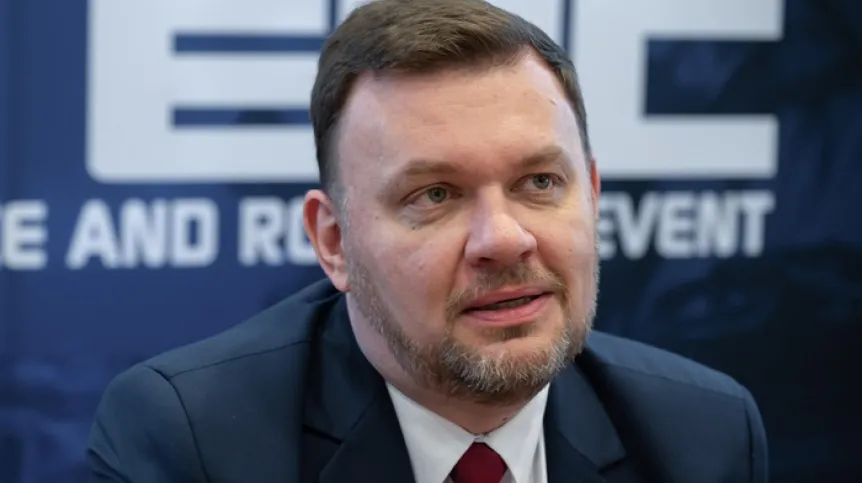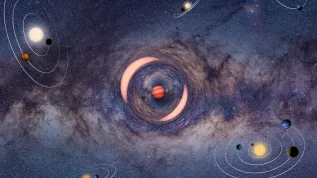
In recent months, the Polish space sector has recorded spectacular successes, including the successful test of the Bursztyn rocket and the launch of the EagleEye satellite, believes Łukasz Wilczyński, president of the European Space Foundation. He adds that the challenge for Poland now is to determine the main directions of development of this sector.
On July 3, the IRL-33 Bursztyn 2-K rocket crossed the conventional boundary of outer space. Also in July, vision systems from the Wrocław company Scanway flew on the new European Ariane 6 rocket, providing engineers with key information about the mission.
A bit later, the first data from the Intuition-1 satellite developed by KP Labs reached Earth. The unique feature of the device is that it digitally processes images in orbit, making it much easier to send them to Earth. According to Wilczyński, this is a pioneering technology on a global scale.
In mid-August, EagleEye, the largest Polish satellite weighing 50 kg, was launched into orbit. The leader was Creotech, the telescope operating on board was developed by Scanway, and the on-board computer by the Space Research Centre of the Polish Academy of Sciences.
'In the meantime, Thorium Space tested an innovative, flat terminal for communicating with satellites. The American-Finnish-Polish company IceEye sent further satellites to its well-known constellation of orbital radar devices', Wilczyński adds.
Many Polish companies have also appeared at important industry conferences and fairs (e.g. SmallSat Conference in the United States), while until recently these were isolated cases. 'We can say that there is a revolution in the Polish space sector', Wilczyński says.
In September, the 10th, anniversary edition of the European Rover Challenge took place in Kraków.
'As the European Space Foundation, the consortium leader, we are also currently trying to ensure that the 2027 International Astronautical Congress will be held in Poland, and we have a very good chance of success. The summer of 2024 showed that the Polish space sector has entered a new level of development', he continues.
'Thanks to the Scanway telescope and the very low orbit of 350 km, EagleEye can take high-resolution photos of the Earth, in visible and infrared light. Such systems already exist in the world, of course, but the most important thing is technological sovereignty. As a country, especially a front-line country, which is also located on the border of NATO and the European Union, we need our own devices of this type', he says.
Wilczyński adds that the satellite will also be of great importance in mitigating the effects of natural disasters, which may occur more often with climate change.
'This instrument will perfectly complement radar satellites, such as those sent by the aforementioned IceEye. Advanced systems for processing this type of data are also being developed in Poland', he says.
The expert points out that when it comes to data processing, the pioneering systems are being created by KP Labs.
'They allow us to process information collected by the satellite in orbit. This is extremely important - for example, the Copernicus satellite system sends petabytes of data. Thanks to solutions such as those created by KP Labs, the amount of information to be processed on Earth can be reduced', he says.
Wilczyński also draws attention to the significance of the launch of the IRL-33 Amber 2-K rocket, designed by engineers from the Łukasiewicz Research Network - Institute of Aviation.
'The rocket launched in July is of course the first step that will pave the way for larger, more powerful rockets, although these will still be suborbital rockets for now. At the same time, many technologies were tested, including a mobile launcher. We will not have rockets like those built by SpaceX for a long time, but we are taking the first important steps in building launch vehicles', he says.
Regarding the planned flight of a Polish astronaut, Wilczyński says it will be an important event both symbolically and practically.
'Sławosz Uznański's flight means that Poland has joined an elite group of countries that have their own people in space. But that is not all - the rules are such that astronauts take experiments of scientists from their countries. They will therefore be able to conduct research that requires microgravity, or other experiments related to space flights. For example, Sławosz will wear a wristband made of nanobiomaterials developed at AGH UST, which will measure various vital parameters of his body. Such technology may also find applications on Earth - a similar wristband in a watch could monitor health. Experiments conducted in space are diverse, however. Some protest that it is an unnecessary expense. That is not true - this research will pay off, it is an investment', he says.
According to the expert, the expansion of the Polish space sector also means the development of various branches of the economy.
'Companies operating in the space industry need suppliers of various components and services. Many of those are not directly related to space. Other companies may therefore receive interesting, lucrative orders. At the same time, the best educated engineers can stay and develop in the country. So we are talking about only benefits', he adds.
Wilczyński believes that Poland has reached the point where it must decide on the main directions of development of the domestic space sector.
'Of course, various fields should be developed, but in my opinion it is necessary to define several main pillars in which Poland will specialise. These will certainly be mainly technical fields, but not only - for example, we have excellent space law experts. Therefore, a debate beyond politics is needed. Defining the main goals will allow us to develop even better', he says.
Wilczyński is an expert in the field of disseminating knowledge about the space sector and new technologies. He is president of the European Space Foundation and president of the international communications network Space Communications Alliance. He is also the founder and former president of the Planet Partners agency, which is a representative of the international GlobalCom PR-Network in Central and Eastern Europe. In addition, he is the originator and organizer of the European Rover Challenge. (PAP)
Marek Matacz
mat/ agt/ mow/ kap/
tr. RL













